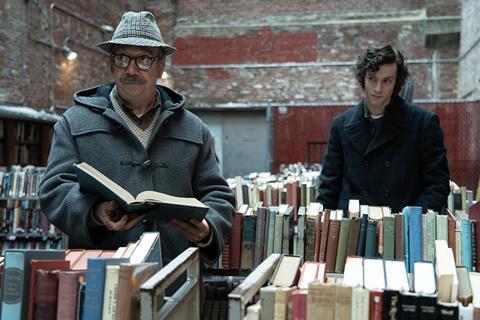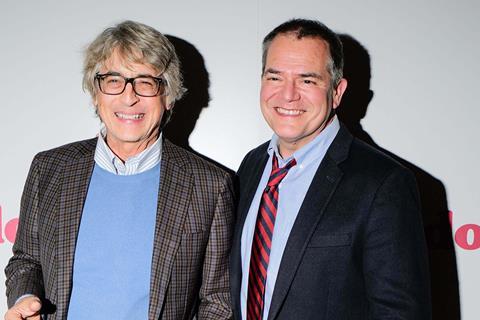David Hemingson had long enjoyed a flourishing TV career as writer and showrunner when he mined his own teenage years with a spec script. He tells Screen about his journey to creating the Oscar- and Bafta-nominated screenplay for The Holdovers.

In 2017, David Hemingson had been a professional television writer for more than 20 years. Since quitting his job as an entertainment lawyer, he had created five series, had been the showrunner of seven, and had written scripts for How I Met Your Mother, Black-ish, Family Guy, Bones and too many other series to name. But he wanted to try something more personal, something that would express his feelings about his parents’ break-up and his time as an awkward scholarship boy at a grand New England prep school. And so he wrote a pilot script entitled Stonehaven.
“My agent was renowned as having the best taste and the worst bedside manner in Hollywood,” remembers Hemingson. “He read it, and said, ‘This is emotional, this is evocative, this is very interesting — and we’ll never be able to sell it to a fucking person. It’s DOA.’”
That’s showbiz. Hemingson went on to develop another series, Whiskey Cavalier for ABC, which began shooting in Prague. What he did not know was that “despite his rather beautiful yet scathing takedown”, his agent had passed the Stonehaven script to another of his clients, Niels Mueller, a writer/director who had been at film school with Alexander Payne, director of Election and Sideways.
Payne had been mulling over an idea for a film about an “ocularly challenged, odiferous professor spending Christmas at prep school with some boys”, but he did not feel familiar enough with that rarefied milieu to write the screenplay himself. After Mueller gave him the Stonehaven screenplay in 2018, he knew who to call.
“I was driving back from LAX [airport],” says Hemingson. “I’d just got off a 14-hour-flight from Prague, where there was a nine-hour time difference from Los Angeles, so I was dog-tired to the point of delirium. I picked up the phone, and he said, ‘David Hemingson? Alexander Payne.’ I thought it was a buddy of mine fucking with me, because he’d called me up once and said, ‘David Hemingson? Francis Ford Coppola.’”
It was a while before Hemingson could believe that he wasn’t being pranked. “I was always a slobbering fanboy,” he says. “I think he’s a great American director. I don’t think he’s a director of comedies any more than John Ford is a director of westerns. John Ford made great movies, and Alexander makes great movies, they just happen to be in certain genres. So to get that phonecall out of the blue from a hero, it was like Charlie Bucket getting the golden ticket in Charlie And The Chocolate Factory. And then the scariest thing was, I’ve got to measure up to this guy.”
Creative success

As is now clear, Hemingson measured up: The Holdovers, a bittersweet comedy drama starring Paul Giamatti, Da’Vine Joy Randolph and Dominic Sessa, has been nominated for five Oscars and seven Baftas, including at both awards for best original screenplay. Acquired by Focus Features after a buyers’ screening in September 2022, the film has grossed $32m worldwide at press time. On Zoom from his home in Los Angeles, Hemingson is quick to credit the cast and crew for the film’s creative success, but the project is a profoundly personal one, with many scenes and characters drawn from his own life.
An adored uncle was the model for Giamatti’s classics professor, and the incident in which Sessa’s teenage student dislocates his shoulder was inspired by a similar injury at the 10th birthday party of Hemingson’s son. Some of the links between the film and its writer are serendipitous. During his second phone conversation with Payne, the director asked, “How do you feel about Paul Giamatti?” Hemingson replied that his own father had studied at Yale with Giamatti’s father, Bart Giamatti, and when Hemingson himself graduated from Yale, Bart Giamatti was the university president who handed out the certificates.
He and Payne clicked, too — although their differences became apparent in their conversations about Payne’s earlier films. Specifically, they differed over the last shot of Sideways, which has Giamatti’s hapless hero Miles knocking on the door of the beautiful Maya (Virginia Madsen) and hoping they will be reunited.
“For me, it was automatic that she answers the door and they fall in love. And [Payne] says, ‘No, no, there’s a family of six living there now, and there’s nothing but a bunch of Maya’s unpaid gas bills.’ Our perspective on life and storytelling and comedy are very similar, but I’m the sentimentalist, comparatively. But I think that contrasting approach served us well on this movie. The chewy caramel centre that I have, and his hard candy shell, they work well together.”
Early on in the writing process, Payne and Hemingson agreed that The Holdovers should be set over the 1970-71 Christmas holiday — and Hemingson started delving into the films of Hal Ashby, Robert Altman and Bob Rafelson. “It was largely because he loves that era and I love that era, but it just so happened that 1970 was an accurate analogue to 2018. The world was on fire, there was a massive amount of racial injustice in this country, so it felt like doing a movie set in 1970 was going to echo in 2018.”
But it took them months to settle on the precise story they wanted to tell. Hemingson would keep sending Payne plot ideas, and Payne would advise him on which ones to pursue. One idea was a “Raymond Chandler meets Roald Dahl” romance between Giamatti’s character and a woman who had lost a hand in an accident. Payne was “so polite and so midwestern” when he suggested that the film should focus more on the teenage boy instead.
Coming up with an abundance of story concepts was nothing new to Hemingson. “I’m fortunate to have had a pretty diverse career,” he says. “I got to do kids’ animation, adult animation, single-camera comedy, multi-camera comedy, hard procedural, soft procedural… so I’ve got various swords in my belt, for want of a better phrase. By the time The Holdovers rolled around, I felt uniquely equipped to look at all elements of the story and play with the pacing and the tone.”
On the other hand, he had to learn a different, more economical style of writing. “The central truth of television is that it’s one long second act. You’re amending and restating your concept over and over again. In film, you have much less time [to tell the story], so you’ve got to make sure every scene and every moment serves not just the characters, and escalates and amplifies who they are, but serves the theme, and helps it crescendo to something that’s going to have an emotional impact at the end.
“That just gets very granular,” Hemingson continues. “On television, I’m writing 40 pages a week sometimes. On The Holdovers, I could work for days and days and months on a scene.”
Lessons learnt, he is currently co-writing a western with Payne, set in Nebraska in 1886. He has also adapted a Nordic noir novel into a feature screenplay. “We have an actor attached. He said, ‘I love this… but I just think there could be more.’ So having done all that compressing and condensing — taking this 500-page book and turning it into a two-hour movie — I’m now blowing it up into a TV series. It’s the reverse process of the granular one that I experienced on The Holdovers.”























No comments yet